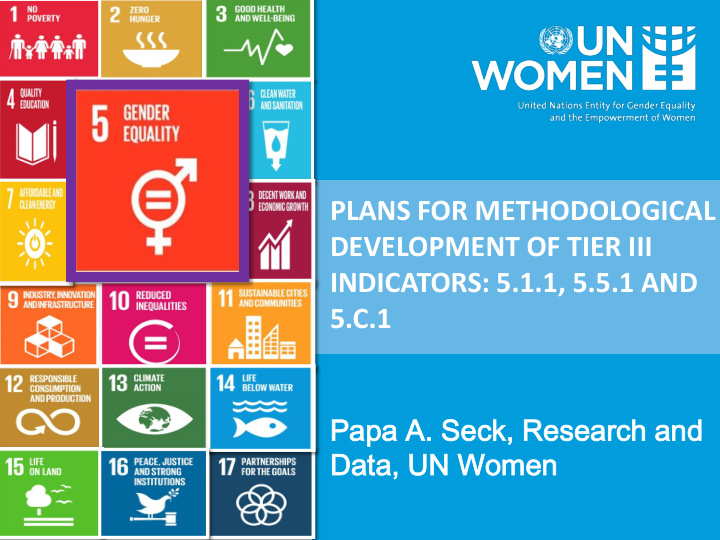



PLANS FOR METHODOLOGICAL DEVELOPMENT OF TIER III INDICATORS: 5.1.1, 5.5.1 AND 5.C.1 Papa pa A. S . Seck, k, Rese sear arch ch and nd Data, ta, UN Wom omen en
Overview 1. Definitions of indicators 2. Current work taking place 3. Plans for future work 4. Timeframe
Indicator definition: 5.1.1 Whether or not legal frameworks are in place to promote, enforce and monitor equality and non-discrimination on the basis of sex Normative basis: International Human Rights Framework (e.g. CEDAW, ICESCR, ICERD, ICCPR, CRPD, CRC; etc.) Measures whether or not: 1) national laws exist to promote gender equality and non-discrimination against women and girls and 2) there exist mechanisms to ‘enforce and monitor’ implementation Possible areas of law (in line with HR obligations) – still to be defined
Indicator definition: 5.5.1 Proportion of seats held by women in national parliaments and local governments Measures women’s proportional representation in two distinct areas of government: a) national parliaments (Tier I) and b) local government (Tier III) Women in local government: indicator refers to the proportion of women holding positions in lower levels of government At least two challenges from a conceptual point of view: What is a local government? – varies across countries. o What positions of decision-making (e.g. local council) o and/or leadership (e.g. head of council) should be taken into account?
Indicator definition: 5.c.1 Percentage of countries with systems to track and make public allocations for gender equality and women’s empowerment Seeks to measure (1) government efforts to track budget allocations and actual expenditures for gender equality throughout the public finance management cycle and (2) to make such information publically available Allocations for gender equality and women’s empowerment are defined as those for which one of the following is met: o (1) Women or girls are the intended beneficiaries; o (2) All benefit but gender equality is a primary objective; and o (3) Gender equality is not a primary objective but action is being taken to close gender gaps.
Current work taking place 5.1.1 – legal frameworks OECD & World Bank currently collect data in various areas of law for most countries; but different methodologies and areas of law covered; and enforce and monitor not measured by either CEDAW Committee captures elements of enforce and monitor but not systematically for all countries; frequency of reporting. 5.5.1 – local government Systematic data compilation at regional level (Europe, LAC and ad-hoc data compilation in Asia-Pacific) But lack of comparability: large differences in indicator definition and data collected 5.c.1 – gender budgeting Data collected as part of the Busan Partnership Agreement (only for developing countries – reporting optional until now) Original indicator requires substantial revisions for comparability
Plans for future work 5.1.1 – legal frameworks Under discussion with potential partners, including OHCHR, World Bank and OECD (Concept paper commissioned; expert group meeting planned for Sept. 2016) Data collection every two to three years, depending on option adopted for data collection (e.g. CEDAW, World Bank or OECD) 5.5.1 – local government Currently undertaking a comprehensive review of Constitutions, Local Government Acts and Electoral Laws to understand structures of local governments (May 2016) Synthesis of existing methodologies and data collection mechanisms & initial consultations with global and regional organizations (e.g. UN Reg. Commissions) 5.c.1 – gender budgeting Baseline data collected in late 2017 to early 2018. Data analyzed and reported in summer of 2018. Data collected every 2 years using the existing Global Partnership Monitoring process and possibly OECD led data collection for developed countries
Timeline: Methodology Development and Testing (example 5.c.1) March April - May July September November Dec- Mar ’17 April ’17 Initial consultations Partner EGM Report Testing of the Presentation of Discussion paper Expert with experts review of the Methodology methodology the final on the indicator/ Group to refine draft and Data and reporting of methodology to methodology Meeting existing methodology collection tools results the IAEG methodology UN Women and UNDP, OECD External Experts UN Women, GRB UN Women, OECD, UN Women, UN Women external experts experts, UN UNDP Selected Min. of on GRB Agencies, OECD, Finance, NWM IAEG members ( both developed and developing countries ), OECD Partners
Recommend
More recommend